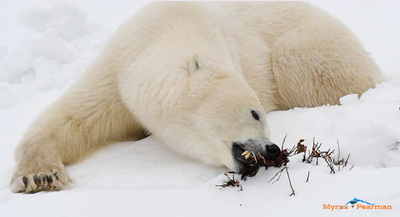 Greetings. I am finally going to write occasional essays for social media. This, my first one, is about polar bears. Last week, I finally realized one of my bucket list dreams to be able to see polar bears up close. I joined a group of other enthusiasts for a one-day bear-watching excursion to Churchill, Manitoba. We departed Calgary at 6:30 AM and arrived back at 8:30 PM. A long but amazing day that took us to the coast of Hudson Bay and into tundra buggies where we spent about seven hours searching for bears and other arctic wildlife. The only downer about this trip, which I had booked back in July, was that I slipped and fell last week, smashing my good long lens on a tree root. McBain Camera in Red Deer (where I buy all my equipment) generously offered to loan me a 150-600 Sigma lens, but after trying it out at home one evening, I realized that it was too heavy for me to hand hold. So, I was forced to settle with my Nikon 80-400. Even with the reach of my new Nikon d500, it was not the ideal lens for this setting. Although it was a thrill to be immersed in this stark and striking northern landscape for a day, it was sobering to see, first hand, the ravages of global climate change on this ecosystem: Hudson Bay hasn’t even started to freeze over yet due to warm conditions, and our guide had never see such slushy ground conditions. This is the time of year that polar bears, which haven’t eaten for several months, congregate and wait for the ice to form on the bay so they can head north and start feeding again on their main prey – the ringed seal. The bears are usually well out on the sea ice by now, and the longer the water takes to freeze, the hungrier they get. Climate change is having an impact on the breeding success of the seals as well—warm conditions affect the stability of their nursery lairs in the snow drifts that form above their breathing holes. If an insufficient snowpack forms over the hole, or if rains cause the drift to melt, the young are exposed to excessive bear predation and/or exposure. One of our first sightings was of a beautiful gyrfalcon. What a magnificent creature to admire while it sat and smiled for us. What a thrill – this was my first good look at these northern falcons. Over the next few hours we were treated to sightings of 13 different bears, from a big old male eating a young cub that he’d recently killed to others just resting or wandering across the tundra. Of special interest to me was to be able to watch a bear grab some kelp (she was sleeping in an area that sometimes gets inundated with seawater during surge tides), lick at it, then fall asleep with the kelp on her paw. Our guide explained that they nibble at the kelp to get their digestive system up and running again, in preparation for their upcoming diet of seal meat. We also saw several small coveys of willow ptarmigan and a silver fox, but they were never close enough to our tundra buggy for me to get any pictures. Next time! The company I travelled with was Canadian Classic Tours ( http://www.classiccanadiantours.com/). I highly recommend them if you’d also like to experience these amazing animals in a unique and disappearing landscape. Click on images below to enlarge and view full frame.
Davina DAly
25/11/2016 05:27:21 pm
As usual, Myrna, outstanding. Thank you for sharing the pictures and the reality of what we are doing to our planet.
Reply
Your comment will be posted after it is approved.
Leave a Reply. |
AuthorMyrna Pearman Archives
August 2022
|
All photos and published works on this website are copyright Myrna Pearman unless otherwise noted.
Re-posting these images or publishing is not permitted without Myrna's written consent.
Copyright Myrna Pearman Publishing 2024- Site design and maintenance by Carolyn Sandstrom
Re-posting these images or publishing is not permitted without Myrna's written consent.
Copyright Myrna Pearman Publishing 2024- Site design and maintenance by Carolyn Sandstrom













 RSS Feed
RSS Feed



8/11/2016
2 Comments